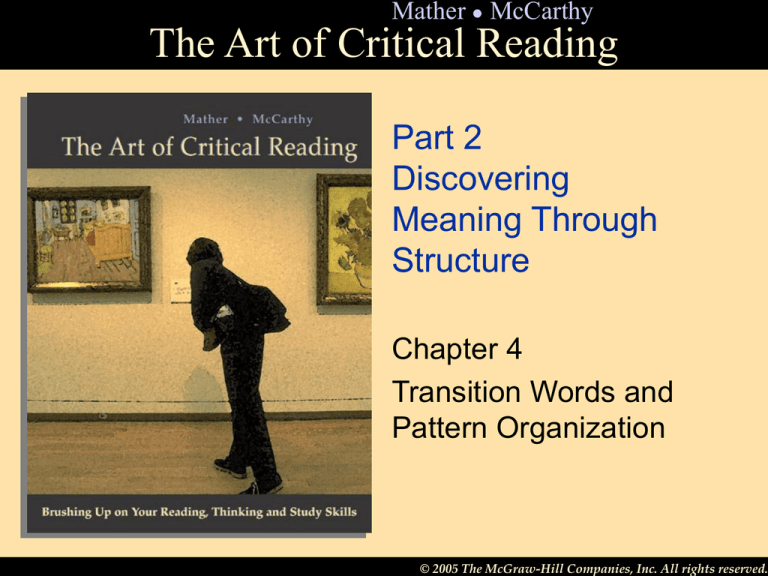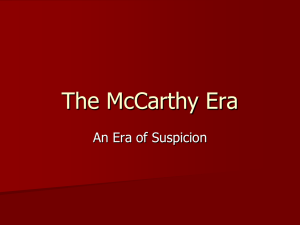
Mather ● McCarthy
The Art of Critical Reading
Part 2
Discovering
Meaning Through
Structure
Chapter 4
Transition Words and
Pattern Organization
© 2005 The McGraw-Hill Companies, Inc. All rights reserved.
Mather ● McCarthy
The Art of Critical Reading
Description of Transition Words
and Patterns of Organization
In your reading it is important
to pay close attention to transition words.
These special words show the relationships
between ideas within sentences and ideas within paragraphs.
Good readers learn to pay attention
to the author’s transition words,
which signal what is ahead.
Part 2: Discovering Meaning Through Structure
Chapter 4: Transition Words and Patterns of Organization
2
© 2005 The McGraw-Hill Companies, Inc. All rights reserved.
Mather ● McCarthy
The Art of Critical Reading
TRANSITION WORDS
Words that can be used to show
classification or division (categories):
break down
combine, combination
lump
category, categorize
divide, division
split
class and subclass
group, grouping
type
classify, classification
kind
Part 2: Discovering Meaning Through Structure
Chapter 4: Transition Words and Patterns of Organization
3
© 2005 The McGraw-Hill Companies, Inc. All rights reserved.
Mather ● McCarthy
The Art of Critical Reading
Words that can be used to show cause and effect relationships:
as a consequence
due to
result, resulting
as a result
for
since
because
for this reason
so
begin
hence
then
bring(s) about
lead(s) to
therefore
consequently
reaction
thus
Part 2: Discovering Meaning Through Structure
Chapter 4: Transition Words and Patterns of Organization
4
© 2005 The McGraw-Hill Companies, Inc. All rights reserved.
Mather ● McCarthy
The Art of Critical Reading
Words that can be used to show comparison:
all
both
like
and
in comparison
likewise
as
just as
similar, similarly
Part 2: Discovering Meaning Through Structure
Chapter 4: Transition Words and Patterns of Organization
5
© 2005 The McGraw-Hill Companies, Inc. All rights reserved.
Mather ● McCarthy
The Art of Critical Reading
Words that can be used to show contrast:
although, though
(in) (by) contrast
on the other hand
but
in opposition
rather than
despite
instead
opposite
even so
nevertheless
unlike
however
on the contrary
yet
Part 2: Discovering Meaning Through Structure
Chapter 4: Transition Words and Patterns of Organization
6
© 2005 The McGraw-Hill Companies, Inc. All rights reserved.
Mather ● McCarthy
The Art of Critical Reading
Words that can be used to show steps in a process:
after
finally
process
afterward(s)
first, second, third
step
at this point
next
then
at this stage
now
later
subsequently
at last
preceding
Part 2: Discovering Meaning Through Structure
Chapter 4: Transition Words and Patterns of Organization
7
© 2005 The McGraw-Hill Companies, Inc. All rights reserved.
Mather ● McCarthy
The Art of Critical Reading
Words that can be used to show examples:
(for) example
specific
specifically
(for) instance
such as
(to) illustrate, illustration
(in) particular
particularly
(to) demonstrate
Part 2: Discovering Meaning Through Structure
Chapter 4: Transition Words and Patterns of Organization
8
© 2005 The McGraw-Hill Companies, Inc. All rights reserved.
Mather ● McCarthy
The Art of Critical Reading
Words that can be used to define:
term, terminology
call, called
refer(s) to
describe(s), described
mean(s), meaning
concept
name
label
define(s), defined
definition
Part 2: Discovering Meaning Through Structure
Chapter 4: Transition Words and Patterns of Organization
9
© 2005 The McGraw-Hill Companies, Inc. All rights reserved.
Mather ● McCarthy
The Art of Critical Reading
Patterns of Organization
Writers organize their supporting sentences and ideas in many ways.
The most common kinds of patterns of organization:
1.
2.
3.
4.
5.
6.
7.
8.
classification and division
cause and effect
comparison and contrast
steps in a process
examples
definition
chronological order
listing
Part 2: Discovering Meaning Through Structure
Chapter 4: Transition Words and Patterns of Organization
10
© 2005 The McGraw-Hill Companies, Inc. All rights reserved.
Mather ● McCarthy
The Art of Critical Reading
A writer’s chosen pattern of organization
will affect the transition words that are selected.
Classification Pattern
Classification is the process of organizing information into categories.
A category is created by noticing and defining group characteristics.
The categories we create make it easier
to analyze, discuss, and draw conclusions.
Often paragraphs are organized using classification.
Part 2: Discovering Meaning Through Structure
Chapter 4: Transition Words and Patterns of Organization
11
© 2005 The McGraw-Hill Companies, Inc. All rights reserved.
Mather ● McCarthy
The Art of Critical Reading
Classification Division
classify, classification
divide, division
group, grouping
split
lump
break down
combine, combination
category, categorize
class and subclass
Part 2: Discovering Meaning Through Structure
Chapter 4: Transition Words and Patterns of Organization
12
© 2005 The McGraw-Hill Companies, Inc. All rights reserved.
Mather ● McCarthy
The Art of Critical Reading
Cause-and-Effect Pattern
In a cause-and-effect relationship,
one thing causes another thing to happen.
The second event is the effect or result of the first event.
Part 2: Discovering Meaning Through Structure
Chapter 4: Transition Words and Patterns of Organization
13
© 2005 The McGraw-Hill Companies, Inc. All rights reserved.
Mather ● McCarthy
The Art of Critical Reading
Cause & Effect
because
as a result
for
consequently, consequence
reason, for this reason
reaction
since
then
Part 2: Discovering Meaning Through Structure
Chapter 4: Transition Words and Patterns of Organization
begin
lead(s) to
bring(s) about
hence
therefore
so
result, resulting
14
© 2005 The McGraw-Hill Companies, Inc. All rights reserved.
Mather ● McCarthy
The Art of Critical Reading
Examples and Illustration Pattern
A paragraph of examples usually gives a general statement of the main
idea and then presents one or more concrete examples
to provide support for this idea.
Many writers place the most important or convincing example
either first, as an attention-getter, or last, as a dramatic climax.
The terms “example” and “illustration” are often used interchangeably.
But an illustration can be thought of as
an example that is longer and more involved.
A main idea might be supported by only one “illustration.”
Part 2: Discovering Meaning Through Structure
Chapter 4: Transition Words and Patterns of Organization
15
© 2005 The McGraw-Hill Companies, Inc. All rights reserved.
Mather ● McCarthy
The Art of Critical Reading
Watch for these transitional words in paragraphs of examples:
(for) example
(for) instance
(to) illustrate, illustration
(in) particular,
particularly
specific,
specifically
(to) demonstrate
such as
Part 2: Discovering Meaning Through Structure
Chapter 4: Transition Words and Patterns of Organization
16
© 2005 The McGraw-Hill Companies, Inc. All rights reserved.
Mather ● McCarthy
The Art of Critical Reading
Compare/Contrast Pattern
A comparison shows similarities, while a contrast shows differences.
Sometimes a writer both compares (tells the similarities)
and contrasts (tells the differences)
at the same time.
Part 2: Discovering Meaning Through Structure
Chapter 4: Transition Words and Patterns of Organization
17
© 2005 The McGraw-Hill Companies, Inc. All rights reserved.
Mather ● McCarthy
The Art of Critical Reading
Study Technique # 5 Compare-and-Contrast Chart
A compare-and-contrast chart
shows similarities
between two or more things,
differences between two or more things,
or similarities and differences
between two or more things.
Part 2: Discovering Meaning Through Structure
Chapter 4: Transition Words and Patterns of Organization
18
© 2005 The McGraw-Hill Companies, Inc. All rights reserved.
Mather ● McCarthy
The Art of Critical Reading
Comparison Contrast
all
on the other hand
nevertheless
and
though
(in) (by) contrast
as
unlike
on the contrary
both
yet
Instead
like
although
while
similar, similarly
but
opposite
compare
Part 2: Discovering Meaning Through Structure
Chapter 4: Transition Words and Patterns of Organization
despite
converse
(in)
comparison
even so
conversely
likewise
however
in opposition
just as
19
© 2005 The McGraw-Hill Companies, Inc. All rights reserved.
Mather ● McCarthy
The Art of Critical Reading
Listing Pattern
When an author simply lists information without regard to order,
the pattern of organization is referred to as simple listing or enumeration.
Sometimes authors use
numbers (1,2,3),
letters (a, b, c)
or asterisks (*)
to show the individual items in the list.
At other times, they will say first, second, third, etc.
Sometimes they use words such as in addition, next, or finally.
Often a colon will be used as punctuation at the start of a list.
A variation of the word follow may indicate that a list is about to begin.
Part 2: Discovering Meaning Through Structure
Chapter 4: Transition Words and Patterns of Organization
20
© 2005 The McGraw-Hill Companies, Inc. All rights reserved.
Mather ● McCarthy
The Art of Critical Reading
Steps in a Process Pattern
In the steps-in-a-process pattern,
something is explained or described in a step-by-step manner.
A transition word often introduces each step.
Scientific writing commonly follows this particular pattern.
In addition, anytime we try to demonstrate
how to make or do something,
we are probably using this pattern.
Part 2: Discovering Meaning Through Structure
Chapter 4: Transition Words and Patterns of Organization
21
© 2005 The McGraw-Hill Companies, Inc. All rights reserved.
Mather ● McCarthy
The Art of Critical Reading
Transition Words in the Steps in a Process Pattern
first, second, third
then
next
finally
at this point
at this stage
after
Part 2: Discovering Meaning Through Structure
Chapter 4: Transition Words and Patterns of Organization
afterward
now process,
step, level
later
at last
subsequently
preceding
22
© 2005 The McGraw-Hill Companies, Inc. All rights reserved.
Mather ● McCarthy
The Art of Critical Reading
Definition Pattern
A paragraph of definition will
define,
clarify,
or explain a key term.
Definitions can be developed by providing
dictionary meanings
or personal meanings.
They can also be developed with examples or
by comparing and contrasting the key term to other words.
Part 2: Discovering Meaning Through Structure
Chapter 4: Transition Words and Patterns of Organization
23
© 2005 The McGraw-Hill Companies, Inc. All rights reserved.
Mather ● McCarthy
The Art of Critical Reading
Transition Words in the Definition Pattern
mean(s), meaning
call, called
concept
refer(s)
describe(s), described
term, terminology
name, label
define(s), defined, definition
Part 2: Discovering Meaning Through Structure
Chapter 4: Transition Words and Patterns of Organization
24
© 2005 The McGraw-Hill Companies, Inc. All rights reserved.
Mather ● McCarthy
The Art of Critical Reading
Study Technique # 6 Mapping
Mapping is similar to outlining in that it shows
how the main points relate to each other,
but it is more visual and less formal.
Both outlining and mapping
are useful for organizing information.
Part 2: Discovering Meaning Through Structure
Chapter 4: Transition Words and Patterns of Organization
25
© 2005 The McGraw-Hill Companies, Inc. All rights reserved.
Mather ● McCarthy
The Art of Critical Reading
Chronological Order Pattern
The word chronological comes
from the Greek root chron, which means “time.”
The chronological pattern of organization involves arranging events
in the order in which they actually happened.
For this reason, historical essays and other articles
that are date-oriented are usually organized by this method.
Paragraphs written with this pattern are usually very easy to recognize.
Part 2: Discovering Meaning Through Structure
Chapter 4: Transition Words and Patterns of Organization
26
© 2005 The McGraw-Hill Companies, Inc. All rights reserved.
Mather ● McCarthy
The Art of Critical Reading
Study Technique # 7 Time Lines
A time line is a specialized way of organizing information.
Time lines are useful when material needs to be organized
chronologically by dates, such as in a history class,
though you could have a need to make one in almost any other class too.
All that a time line does is list dates in chronological order
along a line and then assign information to the dates.
You can make a time line vertically (up and down) or horizontally (across).
How specific you want to make a time line in terms of the number of dates
and the amount of information you assign to each date
depends on the reading material and your needs.
Part 2: Discovering Meaning Through Structure
Chapter 4: Transition Words and Patterns of Organization
27
© 2005 The McGraw-Hill Companies, Inc. All rights reserved.
Mather ● McCarthy
The Art of Critical Reading
Some key transition words for chronology
before
after
during
following
in the years
later
any month (May, June, etc.)
any year (2004 etc.)
then
finally
always
at last
currently
frequently
first, second etc.
in the meantime
until
when
Part 2: Discovering Meaning Through Structure
Chapter 4: Transition Words and Patterns of Organization
soon
next
any time (12:00 etc.)
any season (winter etc.)
presently
preceding, previous
immediate, immediately
era, period
earlier
28
© 2005 The McGraw-Hill Companies, Inc. All rights reserved.
Mather ● McCarthy
The Art of Critical Reading
Additional Transition Words
While lists of transition words are helpful,
the groupings of the words given in this section are not perfect.
Many of these words may be placed in more than one category.
The only way to truly determine
the function
of a transition word
is by studying the context
of the sentence and the paragraph.
Part 2: Discovering Meaning Through Structure
Chapter 4: Transition Words and Patterns of Organization
29
© 2005 The McGraw-Hill Companies, Inc. All rights reserved.
Mather ● McCarthy
The Art of Critical Reading
Summary and Conclusion
Spatial Order
finally
in brief
in short
over all
hence
so
therefore
thus
to conclude
to sum up
in summary
in conclusion
above
below
beyond
on top
underneath
near
next to
front
center
left
right
Part 2: Discovering Meaning Through Structure
Chapter 4: Transition Words and Patterns of Organization
30
© 2005 The McGraw-Hill Companies, Inc. All rights reserved.
Mather ● McCarthy
The Art of Critical Reading
Reversal
Addition
unlike
nevertheless
instead
yet
still
granted that
again
also
and
another
further
furthermore
in addition
moreover
as well as
besides
too
Part 2: Discovering Meaning Through Structure
Chapter 4: Transition Words and Patterns of Organization
31
© 2005 The McGraw-Hill Companies, Inc. All rights reserved.
Mather ● McCarthy
The Art of Critical Reading
Emphasis
Concession
as indicated
as noted
here again
once again
to repeat
It’s important to remember
truly
certainly without a doubt
unquestionably
to emphasize
despite
although
in spite of
even though
Part 2: Discovering Meaning Through Structure
Chapter 4: Transition Words and Patterns of Organization
32
© 2005 The McGraw-Hill Companies, Inc. All rights reserved.
Mather ● McCarthy
The Art of Critical Reading
Study Technique # 8 Summarizing Longer Articles
Summarizing simply means restating the main ideas in your own words.
Begin by identifying the main idea of the article. What is the most important
point the author is trying to make?
Identify the main supporting ideas, and list at least two details for each
important point.
Keep in mind that you are reporting
the author’s viewpoints
and not your own.
Part 2: Discovering Meaning Through Structure
Chapter 4: Transition Words and Patterns of Organization
33
© 2005 The McGraw-Hill Companies, Inc. All rights reserved.
Mather ● McCarthy
The Art of Critical Reading
When writing a summary, you never write something like,
“I feel,”
or
“I think,”
or
“it seems to me.”
Instead, you always write only the author’s opinions.
In a summary, it is always what the author
feels, thinks, or believes.
Your completed summary should contain
no trivia (useless or unimportant information),
and should not be redundant (give information more than once).
Part 2: Discovering Meaning Through Structure
Chapter 4: Transition Words and Patterns of Organization
34
© 2005 The McGraw-Hill Companies, Inc. All rights reserved.
Mather ● McCarthy
The Art of Critical Reading
Chapter 4 Test Taking Tip--Dealing with Test-taking Anxiety
While the key to most successful test-taking situations
is adequate preparation,
you also need to maintain a positive attitude
and stay relaxed.
Part 2: Discovering Meaning Through Structure
Chapter 4: Transition Words and Patterns of Organization
35
© 2005 The McGraw-Hill Companies, Inc. All rights reserved.
Mather ● McCarthy
The Art of Critical Reading
If you answer YES to several of these questions,
you may be highly anxious about tests.
1. I have trouble sleeping the night before a test.
2. I have visible signs of nervousness right before a test (sweaty palms, shaky hands).
3. I have butterflies in my stomach or feel nauseated.
4. I am irritable and hard to be around before a test.
5. I worry about how others are doing on the test
6. My mind goes blank during the test or I am unable to recall information.
7. I have difficulty choosing answers.
8. I make mistakes on easy questions or put answers in the wrong places.
9. I am always afraid that I will run out of time.
10. I remember the information that I forgot after I have turned in the test.
Part 2: Discovering Meaning Through Structure
Chapter 4: Transition Words and Patterns of Organization
36
© 2005 The McGraw-Hill Companies, Inc. All rights reserved.
Mather ● McCarthy
The Art of Critical Reading
Relaxation Techniques
1. Take long and deep breaths to calm yourself.
After a few minutes, close your eyes and imagine a favorite place.
Make this mental scene as detailed as you possibly can.
2. Try to relax your whole body by starting with your feet first.
Work your way through your body -- your legs, your arms, your chest.
3. If permissible, suck on a piece of hard candy.
4. View the test as an opportunity for self-discovery and not as a win/lose proposition.
5. If you feel that your anxiety is overwhelming,
you may want to get help from your college counseling center.
Part 2: Discovering Meaning Through Structure
Chapter 4: Transition Words and Patterns of Organization
37
© 2005 The McGraw-Hill Companies, Inc. All rights reserved.





